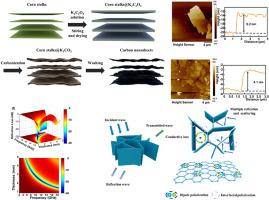高效电磁波吸收用玉米秸秆碳纳米片的绿色合成
IF 8.2
2区 材料科学
Q1 MATERIALS SCIENCE, MULTIDISCIPLINARY
引用次数: 0
摘要
电子设备产生的电磁污染日益严重,要求开发高性能、环保的电磁波吸收材料。在此,我们报告了一种简单而可持续的策略,通过草酸钾活化和随后的碳化,从玉米秸秆中合成超薄碳纳米片。制备的碳纳米片具有独特的分层多孔结构,厚度为10nm,具有1649.7 m2/g的超高比表面积和0.97 cm3/g的大孔体积。通过优化热解温度,该材料获得了优异的EMW吸收性能:在10.0 GHz处,厚度为2.6 mm时,反射损耗最小(RLmin)为−70.8 dB;在1.9 mm处,有效吸收带宽(EAB)为5.3 GHz (12.7-18.0 GHz)。值得注意的是,当厚度从1.0 mm变化到5.0 mm时,累积EAB扩展到14.0 GHz (4.0-18.0 GHz),在13.6 GHz (4.4-18.0 GHz)范围内RLmin值低于- 20 dB。优越的性能源于阻抗匹配、多次散射/反射、导电损耗和极化损耗的协同效应。这项工作不仅推进了下一代EMW吸收应用的生物质衍生碳材料,而且为农业废弃物的再利用提供了一种绿色和具有成本效益的途径,解决了环境和技术挑战。本文章由计算机程序翻译,如有差异,请以英文原文为准。

Green synthesis of carbon nanosheets from corn straw for high-performance electromagnetic wave absorption
The escalating electromagnetic pollution from electronic devices necessitates the development of high-performance and eco-friendly electromagnetic wave (EMW) absorbing materials. Herein, we report a facile and sustainable strategy for synthesizing ultra-thin carbon nanosheets derived from corn straw via potassium oxalate activation and subsequent carbonization. The as-prepared carbon nanosheets exhibit a unique hierarchical porous structure with a thickness of <10 nm, an ultrahigh specific surface area of 1649.7 m2/g, and a large pore volume of 0.97 cm3/g. By optimizing the pyrolysis temperature, the material achieves exceptional EMW absorption performance: a minimum reflection loss (RLmin) of −70.8 dB at 10.0 GHz with a thickness of 2.6 mm, and a broad effective absorption bandwidth (EAB) of 5.3 GHz (12.7–18.0 GHz) at 1.9 mm. Remarkably, when the thickness is varied from 1.0 mm to 5.0 mm, the cumulative EAB expands to 14.0 GHz (4.0–18.0 GHz), with RLmin values below −20 dB across 13.6 GHz (4.4–18.0 GHz). The superior performance stems from synergistic effects of impedance matching, multiple scattering/reflection, conductive loss, and polarization loss. This work not only advances biomass-derived carbon materials for next-generation EMW absorption applications but also provides a green and cost-effective pathway for repurposing agricultural waste, addressing both environmental and technological challenges.
求助全文
通过发布文献求助,成功后即可免费获取论文全文。
去求助
来源期刊

Materials Today Nano
Multiple-
CiteScore
11.30
自引率
3.90%
发文量
130
审稿时长
31 days
期刊介绍:
Materials Today Nano is a multidisciplinary journal dedicated to nanoscience and nanotechnology. The journal aims to showcase the latest advances in nanoscience and provide a platform for discussing new concepts and applications. With rigorous peer review, rapid decisions, and high visibility, Materials Today Nano offers authors the opportunity to publish comprehensive articles, short communications, and reviews on a wide range of topics in nanoscience. The editors welcome comprehensive articles, short communications and reviews on topics including but not limited to:
Nanoscale synthesis and assembly
Nanoscale characterization
Nanoscale fabrication
Nanoelectronics and molecular electronics
Nanomedicine
Nanomechanics
Nanosensors
Nanophotonics
Nanocomposites
 求助内容:
求助内容: 应助结果提醒方式:
应助结果提醒方式:


